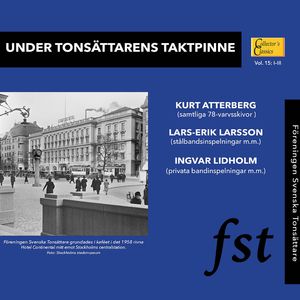Show results for
Deals
- Blu-ray Outlet
- New Release 4K
- New Release Blu-ray
- New Release DVD
- New Release Gifts
- New Release Music
- New Release Vinyl
- Top Seller 4K
- Top Seller Blu ray
- Top Seller DVD
- Top Seller Vinyl
- top sellers all movies
- top sellers all music
- Top Selling Gifts
- TV Outlet
- Top Seller Music
- DVD Outlet
- In Stock Outlet
- Music Outlet

Under Tonsattarens Taktpinne
- (3 Pack)
- Format: CD
- Release Date: 24/05/2019

Under Tonsattarens Taktpinne
(3 Pack)
- Artist: Atterberg
- Label: Caprice
- Genre: Classical
- UPC: 7391782219203
Product Notes
This unique collection of recordings features three major Swedish composers of the 20th century conducting their own works. Kurt Atterberg began studying music in 1902 after having been inspired by a concert by the Brussels String Quartet. Six years later he became a performer in the Stockholm Concert Society, now known as the Royal Stockholm Philharmonic Orchestra. That same year he published his first work- Rhapsody for Piano and Orchestra, Op. 1. His String Quartet No. 1 in D major, Op. 2, soon followed. He studied both electrical engineering at the Royal Institute of Technology and music at the Royal College of Music, Stockholm. Lars-Erik Vilner Larsson was born in Åkarp in 1908, the son of a factory worker and a nurse. He studied with Ellberg at the Stockholm Conservatory (1925-1929) and with Alban Berg and Fritz Reuter in Vienna and Leipzig (1929-1930), then worked for Swedish radio and taught at the Stockholm Conservatory (1947-1959) and Uppsala University where he held the position as Director musices (1961-1966). His style as a composer is eclectic, ranging from the late Romantic to techniques derived from Arnold Schoenberg's twelve-note system, but original in method. He was the first Swede to write serial music. Ingvar Lidholm was born in Jönköping. By age twelve, he was writing songs in a tonal and romantic idiom, which led gradually to exercises of larger proportions, including music for full orchestra. This early period also included orchestration studies with Natanael Berg in Stockholm. Lidholm's primary performance area was stringed instruments; he eventually studied and mastered all four instruments of the string family. He went on to compose a number of works of varying genres, and found success in the mid-twentieth century.


